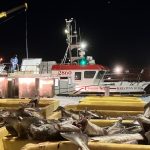Catch limits for Southern New England winter flounder have been raised by 40 percent for the next fishing year, which begins May 1. The federal regulators also said that under the existing regulations they cannot legally possess or land this fish. With the limit up to 1.6 million pounds from 1.1 million, the increase means that a further 500,000 pounds of winter flounder, a vulnerable stock, can be discarded.
Steve Cadrin, a professor at the School for Marine Science and Technology at UMass Dartmouth, and chairman of the New England Fishery Management Council’s science and statistical committee, said that for the National Marine Fisheries Service to put this forward as an example of flexibility is really a slap in the face. He told that this rule allow more discard of winter flounder. He said that fishermen don’t benefit a bit from that increase because it’s still a no-possession fishery. It’s 40 percent more fish being discarded overboard.
Tom Nies, a senior analyst with the New England Fishery Management Council, said that the council put forward the zero catch limit because we don’t want people targeting it. Giving fishermen the flounder, commonly known as blackbacks, would actually increase the discard rate, according to James Odlin, a council member and a commercial fisherman.
Although catch limits are intended to rebuild depleted stocks, very few discarded fish survive being caught in a trawl. This species provides a graphic example of the challenges facing regulators as they try to develop management plans for individual stocks in a multi-species fishery.








